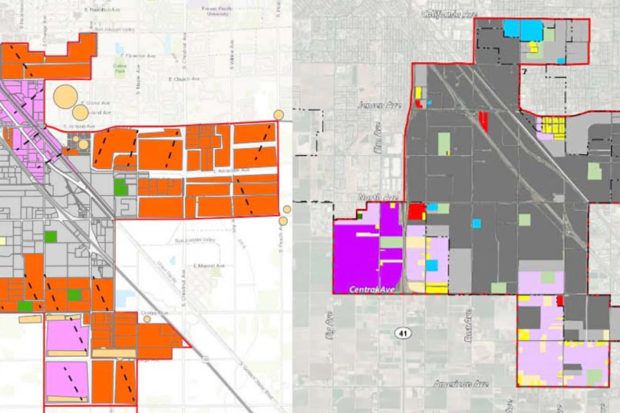
There’s fresh rot at the core of Fresno politics. Sprawl developers have long controlled land-use decisions by simply providing cash to City Council members and candidates, but infection rates in the apple that is our city of a half million souls have soared recently. Campaign contributions from a new disease vector—builders of warehouse distribution centers—are darkening planning maps with grey pixels, marking tracts of land for their future industrial and trucking center growth areas.
What the maps fail to show are the people living in those gray sacrifice zones where they will eventually see family members’ scans and X-rays similarly darkened. Toxic pollutants carried by air, water, soil and food act as epigenetic triggers of fatal and life-limiting chronic conditions that people raised in the city’s northern, less polluted, areas experience at much, much lower rates. It’s a deadly combination of high levels of exposure over long periods of time due to Fresno’s notoriously stagnant air, concentrations of pollution and waste companies, and segregation.
The latest case example of political malfeasance and future human suffering is found on Elm Avenue in southwest Fresno, the result of a classic mix of Fresno politics ranging from “business friendly” elected officials (see “City Seeks to Protect Polluters” in this issue) to institutional disregard for toxic air pollution’s deadly impacts on human health.
Leading the rezone pack is Henry R. Perea. The former City Council member, it turns out, is a block off the old chip. He, too, has become a lobbyist, just like son Henry T., who flipped to the dark side six years ago and is now a registered Chevron frontman. Henry R. represents SDG Fresno 570, LLC, as a registered lobbyist, according to Dympna Ugwu-Oju’s reporting in the Fresno Bee.
The elder Perea finally registered as a lobbyist in March, despite having begun his lobbying as early as February. SDG is a major landowner at the site through its related company, ICC Stravinski. The industrial development firm has been generous with campaign contributors to daughter Annalisa Perea’s bid for City Council, with $27,500 given so far through various individuals, businesses and at least one PAC, and this is the first time in memory a candidate for a council seat in City Hall had a parent registered as a lobbyist there.
But despite its 92.5 acres running more than half a mile along Elm, that proposed rezone looks like a mere postage stamp next to the 8,000 acres—five square miles—of industrial growth announced for Central and Southeast Fresno by city planners in April.
Leading that pack is police chief turned mayor Jerry Dyer. His administration began with a holiday season administrative approval of a second Amazon warehouse immediately adjacent to highly vulnerable children with support from the increasingly inane Miguel Arias, District 1’s city rep; Arias utilizes one side of his mouth to oppose the Elm Avenue rezone and the other to say he wants it before the City Council for a “legislative solution.” That’s gaslighting.
But as many fact-defying, rhetorical acrobatics Arias might share with the former president, Dyer is taking it to a whole new level with the Beautify Fresno campaign. The city-sponsored neighborhood cleanup effort has been turning out hundreds of volunteers once or twice a month to different parts of the city, their Saturday morning exertions supported with city staff time, public resources and a volunteer advisory board stuffed with ministers of nondenominational evangelical Christian churches there to advise them all.
Many White people from north Fresno congregations are finding themselves in parts of town they’d never visit on their own. Now they’re parachuting in to clean it up, missionary-like. Local residents join in, too, exhorted to help by their City Council representatives. The mayor and media show up and thousands of pounds of trash are collected and hauled away, trees are even sometimes planted.
Everyone involved feels that sense of accomplishment and hope for Fresno. They come to believe a sustained campaign of volunteers and grants from state agencies and foundations will create a local culture of cleanliness, order and pride.
The underlying premise is that the problem with our city is us. We, the residents, you and me, all of us are to blame for the trash strewn landscapes, which in turn are choking our economic health. Because what responsible employer will want to locate in a place with such low self-esteem? It’s our responsibility to clean it up, to beautify this city.
But beauty, they say, is only skin deep. And as furiously as the mayor and company might scrub away at Fresno’s admittedly dusty veneer, beneath the surface city leaders are displaying an ugliness that cannot be washed away. Environmental laws have been flouted to allow massive warehouses to be built without any public health protections; that kills people. Trash accumulates where neighborhoods lack opportunity and basic public services. It’s a symptom of much deeper problems.
But Dyer is following the old, ugly Fresno path. He had a second Amazon warehouse administratively approved in mid-December and is now trying to put green lipstick on the city’s corpse of an industrial planning process with a series of surprisingly flawed environmental review efforts. To truly beautify Fresno, courage is needed, strength of character and integrity—qualities sorely lacking in our elected decision-makers in City Hall.
